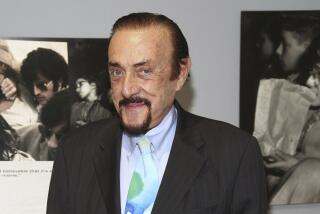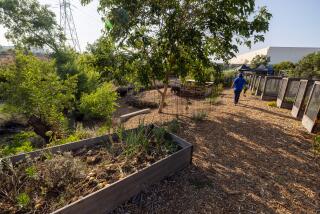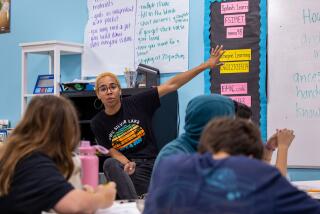Scientist Tests His Theory of Learning on Students at Thousand Oaks School : Education: Official at high-tech firm is teaching third-graders to find answers through research and experimentation. He wants them to ask, ‘Why?’
- Share via
Carl Friedlander of Thousand Oaks wanted to improve the quality of college graduates who apply for scientific jobs at the high-tech Westlake Village firm where he is an executive.
So Friedlander went all the way back to the original source: elementary school.
For the record:
12:00 a.m. Dec. 2, 1993 For the Record
Los Angeles Times Thursday December 2, 1993 Ventura West Edition Metro Part B Page 4 Column 4 Metro Desk 1 inches; 28 words Type of Material: Correction
Wrong name--A photo caption Tuesday incorrectly reported the name of a third-grade student in a special science class at University Elementary School in Thousand Oaks. The student is Brianna LaWall.
Since the school year began, the chief scientist and vice president of ISX Corp. has spent one morning a week challenging a class of third-graders at University Elementary School in Thousand Oaks to think and ask, “Why?”
The youngsters have used experimentation to answer their own questions about subjects that interest them, Friedlander said. After gathering data, the children will graph the results and ultimately analyze the meaning.
The idea is not to teach the children science facts they will remember forever, but to teach them how to find answers, said Friedlander, who directs research primarily on military computer software at ISX.
“What I’m trying to do is teach them the method of science, because once you have the method you can learn anything,” Friedlander said. “They’re learning procedures that they can apply to everything.”
Little do they know, the children are more than students for Friedlander to teach. They also are Guinea pigs for Friedlander to test how the youngest students adapt to playing a more active role in learning science, he said.
Friedlander said he hopes to write up the results of his experiment as a guide for elementary science instruction statewide or incorporate them into educational software for teachers.
If they can grasp scientific methods, the youngsters will get a jump on many college graduates who know lots of facts but need direction to complete a task, Friedlander said.
“We desperately need people who can think,” he said. “I want people who can question what’s going on. I want people who can come up with new ideas.”
*
The earlier the exposure to science, the better, Friedlander said. By the time students get to fifth or sixth grade, they generally are either bored or intimidated by science, he said.
From his vantage point observing the class, University Principal Alan Friedenberg said the experiment has been a great success.
“These students are engrossed in what they’re doing,” Friedenberg said. “They’re speaking a language they couldn’t six weeks ago. They understand that finding answers requires predicting, measuring and analyzing. To me, this is what it’s all about.”
In small groups Monday, the students ran tests to gather information for charts and graphs that will show them patterns or averages.
Weeks before the time for hands-on work arrived, the students had determined something of interest to them and researched it by checking out books from the library and compiling lists of information, Friedlander said.
Once they had learned as much as they could, the students discussed questions they still didn’t know the answer to but wanted to find out, Friedlander said. And their experiments were born, Friedlander said.
“That’s the first thing, to sit the kids down and figure out what they are just madly interested in,” Friedlander said.
Some of the students said they liked birds. They decided to test whether big birds and small birds have the same number of bones. The group started by boiling and deboning turkeys, ducks and Cornish hens for comparison.
Once the bones were dried, the students counted them while gluing them onto a piece of paper in the shape of a bird as shown on a skeletal diagram they used for a guide.
As she glued her duck’s bones onto construction paper, Melinda Gibbs said she suspected that bigger birds had more bones, but not enough data was collected yet to know for sure, she said.
The experimentation made class more interesting, Melinda, 9, added, “because we’re figuring it out for ourselves.”
Jon Dingman, 8, and his group were testing various brand-name batteries to see which ones really lasted longer, as the television ads claimed. Marking data on the group’s sheet every 15 minutes, he said the experiment made learning “a little funner.”
“We get to do something instead of school,” Jon said.
Another group wondered whether taller people could jump higher and farther than shorter people. They spent their lab time measuring each other’s height and then leaping along a tape measure on the floor over and over.
Two students who selected fish as their topic wanted to know if the creatures got their bright colors from their scales or their skin. They picked scales from trout and goldfish to compare under a microscope.
Friedlander’s work went further than most science lessons in elementary school, because he did not dictate the experiments or end them once the lab activity was over, teacher Kathy Benioff said. Benioff helped Friedlander translate his lessons into third-grade language.
*
The students are drawing their own conclusions about the results--and possibly discovering new questions, Benioff said.
“These students can look at anything now and say ‘What don’t I know and how can I find out?’ ” said Benioff, a 14-year teaching veteran and mentor teacher in the district.
If that is what the children ultimately learn, then his experiment has been a success, Friedlander said. “The underlying question is always, why?” he said.
And if they have fun in the meantime, he added, “maybe they will grow up not being afraid of science.”
It doesn’t hurt that Friedlander is a respected professional in his field, said Benioff, appealing for other volunteers with similar credentials.
“It’s highly motivational to the children,” she said. “They’re in awe of him.”
More to Read
Sign up for Essential California
The most important California stories and recommendations in your inbox every morning.
You may occasionally receive promotional content from the Los Angeles Times.










